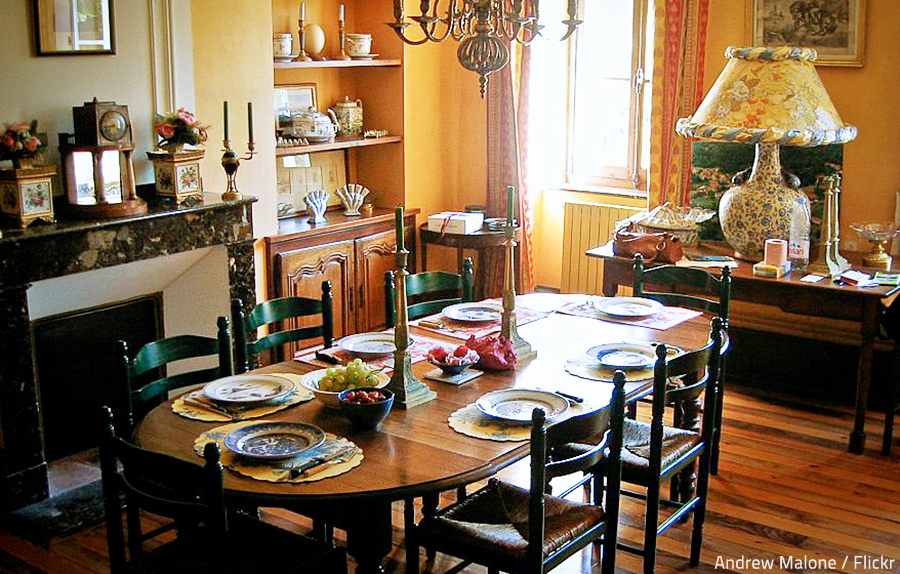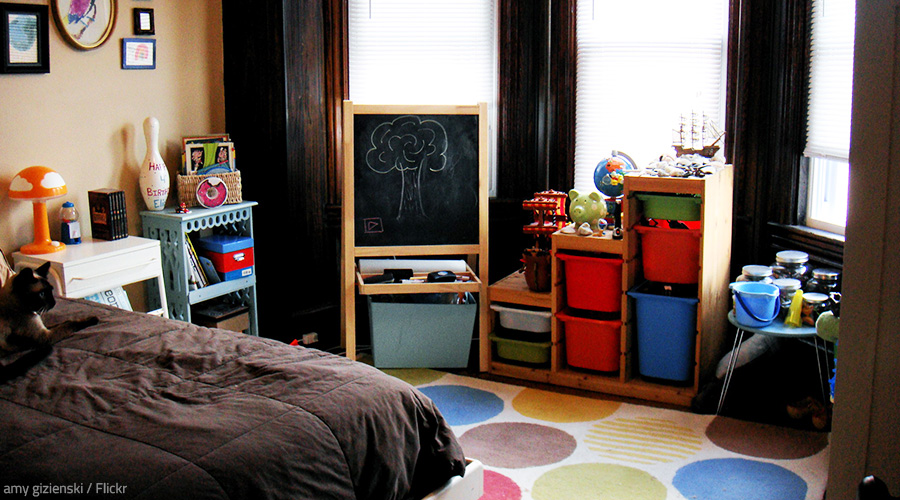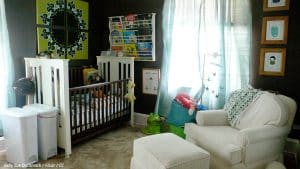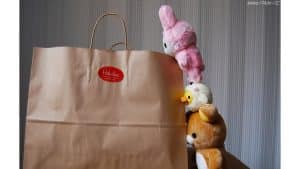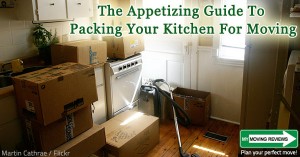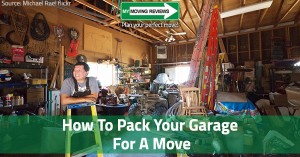Room By Room Packing Checklist
Now that you’re familiar with the most fundamental packing rules, it’s time to proceed with our comprehensive room by room packing list that will give you the specifics of packing every different area of your home:
Garage and Storage Areas
The garage, basement, attic, tool shed, and other storage areas of your home should be the first to pack for a move because they are the toughest rooms to organize and get ready for relocating. You will need all your energy and resolution in order to successfully pack these typically overstuffed rooms, so you need to deal with them first – while you’re not yet fatigued from the arduous packing process. Keep in mind that storage areas not only take a very long time to pack, but are also extremely difficult to prepare for moving, as they are filled with oddly-shaped, heavy, and dangerous items.
Hazardous materials
Garages and tool sheds often contain items that are forbidden for transportation because of their hazardous nature – oils, paints, cleaners, pesticides, fertilizers, etc. You need to find a way to move such non-allowable items yourself, use them up, or properly dispose of them prior to your move.
Gas-powered equipment
- Drain the fuel from any gas-powered items you intend to relocate;
- Put protective covers on chain saws, lawn mower blades and grills;
- Remove any detachable parts from your gas-powered equipment and pack them separately;
- Secure non-detachable parts safely in place.
Power tools
- Remove any detachable parts from the power tools you’re going to take to your new home and pack them in strong cardboard boxes;
- Wrap the tools with bubble wrap or old towels to protect them from damage during the transportation;
- Pack them in their original boxes or boxes with similar sizes.
Hand tools
- Pack hand tools in their original tool boxes;
- Group hand tools that didn’t come in a box (or you don’t keep the box) according to their size and purpose and pack them in sturdy medium-sized moving boxes. Take care to perfectly immobilize the items in a box.
Garden tools
- Wrap blades and sharp-edged tools in bubble wrap or old towels and use heavy duty packing tape to keep the wrapping in place;
- Pack smaller yard tools in sturdy medium-sized boxes. Provide sufficient padding to prevent shifting during transportation;
- Bundle garden tools with long handles, tie them up with a rope, and wrap them in old blankets for better protection.
Lawn and deck furniture
- Remove decorative cushions and furniture paddings and pack them in separate boxes or garbage bags;
- Clean the furniture and dismantle it as much as possible. Wrap every disassembled part, as well as the entire furniture piece, in old blankets or other adequate protective materials. Use plastic wrap or packing tape to keep the wrappings in place. Place small hardware parts in sealable bags and tape them to the furniture they came from;
- Wash patio umbrellas (if any), let them dry, collapse them, and use plastic wrap or large plastic bags to pack them for moving.
Motor vehicles
Cars and other motorized vehicles you want to ship with an auto transport company should also be properly prepared for moving. You can find more detailed information at the links below:
How to prepare a car for shipping; How to move a motorcycle across country
See also: How to pack a garage for moving
Kitchen
The kitchen is the next biggest challenge you’re going to face when packing your household for moving. It is full of bulky appliances, fragile items, oddly-shaped objects and many other smaller and larger articles. Before you can start packing the kitchen, you need to organize all these things and group them in several categories:
Dishes
- Wrap each individual plate in packing paper or stack kitchen dishes one over the other (separated by Styrofoam or paper plates) and wrap them up in bubble wrap;
- Pack dishes in sturdy, properly cushioned boxes and add plenty of crumpled paper in the carton to prevent the plates from shifting during transit;
- Pack your most delicate and expensive plates in specialized dish boxes;
- Put a final layer of packing paper over the plates before shutting the box close;
- Seal the box and mark it as FRAGILE.
Click here for more information on how to pack dishes for moving.
Cups and bowls
- Wrap teacups, coffee cups, mugs, soup bowls, gravy bowls, sauce containers, pitchers, and other similar items individually with packing paper;
- Nest bowls inside one another and wrap them in two layers of newspaper or bubble wrap;
- Place cups upside down in the moving box, with their handles facing the same direction. When the first row is ready, place a protective layer on top of it and start a second row;
- Pack your kitchen cups and bowls in sturdy boxes and add plenty of cushioning materials inside the cartons;
- Label the boxes as FRAGILE.
Glasses
- Stuff glasses with crumpled paper and wrap the stems with bubble wrap (if applicable);
- Wrap every individual glass in soft packing paper;
- Arrange the glasses in a moving box upright, with their months facing downwards;
- Use cell dividers for your more expensive glasses;
- Fill any empty space in the carton with crumpled paper or other appropriate cushioning materials and lay a piece of packing paper on top of the glasses;
- Tape the box close and write FRAGILE, THIS SIDE UP and HANDLE WITH CARE on it.
See also: How to pack glassware for moving
Pots and pans
- Put a large pot or pan on the bottom of a well-cushioned box, slightly larger than the item itself;
- Place a paper towel, a foam sheet, or a piece of bubble wrap in it and put a smaller pot or pan inside;
- Continue nesting smaller pots and pans until the box is full;
- If any of your pots or pans have glass lids, wrap them separately in a protective layer of bubble wrap and pack them in the same box with the pots or pans they belong to;
- Provide sufficient cushioning inside the box to prevent movement during transportation.
Cutlery and silverware
- Sort kitchen utensils and flatware by type and size;
- Wrap sets of six to eight forks or spoons of the same length together in a sheet of bubble wrap or packing paper, tape the bundle, and place it in a small sturdy box together with other similar packages;
- Wrap kitchen knives in thick towels or several layers of bubble wrap;
- Wrap oddly-shaped utensils (ladles, barbecue tongs, etc.) individually.
Cookbooks
Pack cookbooks as any other books – put them in small boxes, lying flat or standing upright with their open parts facing the box sides. Wrap cookbooks of higher monetary or sentimental value in several layers of soft packing paper for better protection.
Small kitchen appliances
- Make sure your mixers, blenders, toasters, coffee makers, and other small kitchen appliances are completely clean and dry;
- Remove any detachable parts and wrap them separately;
- Pack the appliances in sturdy boxes of appropriate sizes (or in their original boxes if you keep them) and fill up any gaps in the boxes with packing peanuts, foam sheets, old towels, or other appropriate padding.
Large kitchen appliances
- Empty and clean your large kitchen appliances a couple of days before the move;
- Secure appliance doors so that they don’t get open during transit;
- Tape cables and hoses to the items;
- Wrap the entire pieces in moving blankets to prevent scratches, dents, and other damage during the relocation. Use plastic wrap or packing tape to secure the wrapping.
Click here for more useful information on how to pack kitchen appliances for moving.
For kitchen furniture, see the dining room section below.
Bonus tip: Make sure you use up your food supplies before the move – relocating them is not worth it unless you’re moving just across town (in fact, perishable foods are considered non-allowable items, so the movers won’t take them even if you want them to). It may be a good idea to bring along your spices though – they are usually quite expensive, difficult to find, and weigh next to nothing, so they won’t increase the moving costs (just make sure they don’t spill during the relocation). You will most certainly want to relocate your wine collection too, as well as sealed bottles of specialty oils and fine vinegar that cost a lot. (See also: What to do with food when moving).
See also: How to pack a kitchen for moving
Dining Room
Packing a dining room requires a lot of time and care as it is full of delicate and expensive items – artwork, china, crystal, luxurious furniture, etc.
Chinaware and glassware
Use the above tips for packing kitchen dishes, bowls, and glasses when preparing china sets, crystal glasses, and other similar items from your dining room for moving. Keep in mind that they are very delicate and extremely fragile (not to mention – quite expensive), so you need to use high quality packing materials and to be extra careful when getting them ready for shipment. You can find some more useful information on how to pack fragile items for moving here.
Lamps and chandeliers
- Lamps – Remove light bulbs and lamp shades, wrap cords and wires around the base of the lamp, and place each lamp base into a small moving box with plenty of cushioning inside. Wrap lamp shades in soft packing paper or bubble wrap. Stack them from largest to smallest, place them in a sturdy moving box, and fill the carton with crumpled paper or bubble wrap to protect the lamp shades against damage (if you have very delicate or expensive lamp shades, pack them individually);
- Chandeliers – Unhook your chandelier, disassemble it as much as possible (remove cables and wires, chains, light bulbs, lamp shades, prisms, candle cups, ornaments, etc.), wrap the detached components in packing paper (be careful not to lose smaller fastening elements), and wrap each crystal individually in soft packing paper (if applicable). Place the chandelier upright in a heavy duty moving box of appropriate size and use packing peanuts, bubble wrap or foam sheets to immobilize the lighting fixture in the moving container. Place a protective layer of large size bubble wrap on top of the box, seal it tightly, and write FRAGILE and HANDLE WITH CARE on at least three of its sides.
You can find more information on how to pack lamps and lampshades for moving here.
Paintings and photographs
- Use painter’s tape to make a big “X” on the glass surface of a framed picture (it will keep cracked or broken pieces in place if your item gets damaged during transit);
- Wrap every painting and photo with soft packing paper and use packing tape to secure the edges so that the item is wrapped as tightly as possible;
- Add a layer of bubble wrap over the paper-wrapped picture. Make sure the wrapping is well secured with packing tape;
- Place the bundle into a suitable transportation box – use a special picture box or break apart a couple of standard cardboard cartons and fit them around the frames of your painting or photo;
- Add some crumpled paper, packing peanuts, or foam sheets into the corners and sides of the box for added safety;
- If you pack more than one framed item inside the same box, be certain to provide sufficient cushioning between the articles;
- Make sure there is no empty space in the box, so that the packed pictures won’t have any space to move around;
- Run several circles of quality packing tape around the box to prevent it from bursting open during transit;
- Do not forget to label the box as FRAGILE and write any special handling instructions you may have on three or four sides of the carton.
Click here for more details on how to pack pictures and mirrors for moving.
Vases, statues, and other pieces of art are best packed in custom crates. If that is not an option, use small sturdy moving boxes and provide plenty of cushioning for better protection.
Dining room furniture
- Dining room table – Detach the table’s legs and wrap them in bubble wrap. Remove the table extension leaf (if possible) and wrap it in a moving blanket. If you’re moving a drop-side table, lower the table leaves and secure them with packing tape to keep them stable during transit. Fold large pieces of corrugated cardboard around the edges and corners of the table for extra safety. Cover the tabletop with moving blankets. If your table has a glass top, separate it from the base, wrap it in packing paper and bubble wrap and place it in a telescopic box of appropriate size (See also: How to move a dining room table and chairs);
- Chairs – Wrap the arms and legs of your dining chairs with bubble wrap. Protect the upholstered seats and chair backs with stretch wrap. Wrap the entire chairs in moving blankets and use packing tape or ropes to keep the padding securely in place;
- Cabinets and cupboards – Remove all the items from your furniture pieces, clean them well, and disassemble them as much as possible. Put the small hardware parts from each piece of furniture into a separate sealable plastic bag and tape it securely to the corresponding item. Pack larger furniture parts separately (be extra careful with glass elements, such as showcases and glass doors). Protect any protruding parts with bubble wrap and pay special attention to decorative elements. Wrap the entire furniture piece in moving blankets and secure them in place with plastic wrap, packing tape, or ropes. Consider paper or cloth padding for additional protection whenever necessary.
Living Room
The living room is usually the largest room in a house, so it’s only logical that it will take plenty of time and effort to pack. That’s why it comes next in our packing room-by-room checklist.
TV
- Unplug cords and antennas from your TV. Secure cables and wires with straps or cable ties and place all the accessories in a sealable bag;
- If your set is mounted to a wall, detach it carefully and place any hardware parts in the bag with the cords;
- Protect the screen with a piece of clean cardboard;
- Wrap the entire TV in a soft blanket and secure it with packing tape or stretch wrap;
- Put the wrapped TV in a well-padded sturdy cardboard box of appropriate size and fill any empty space in the carton with bubble wrap, foam sheets, or anti-static packing peanuts. Keep in mind that extremely heavy and fragile TVs, such as large plasma TVs, are best packed in their original boxes or custom made wooden crates with sufficient padding inside;
- Seal the box well and label it as FRAGILE.
Click here for more detailed tips on how to pack a TV for moving.
Stereo equipment
- Secure the lasers of compact and digital video disc players with transport screws;
- Use a plastic lock to hold the tone arms of stereo turntables in place (it’s a good idea to tie a piece of string around the arm as well). Secure the platter with appropriate screws;
- Carefully wrap your stereo in a few layers of bubble wrap and place it in an appropriate box (its original box or a special electronics box will be best). Provide plenty of cushioning inside the box, seal it tightly, and label it as FRAGILE.
Speakers
- Wrap all speakers in anti-static bubble wrap;
- Pack smaller speakers in well-padded sturdy moving boxes;
- Wrap larger speakers in moving blankets or other appropriate padding (do not forget to secure the wrapping).
Click here to find out the best way to pack DVD players, VCRs, game consoles, and other electronics you may have in your living room.
Good to remember: When packing electronics, make sure you take a photo of the way cords are wired up before disconnecting them. You may also want to label each cable individually for easier re-connection after the move.
Discs and tapes
Cassette tapes and compact discs should be placed in their cases and placed on edge in small moving boxes (do not forget to line the bottom of the box with a thick layer of crumpled paper). Lay a protective cover (bubble wrap, foam sheets, or crushed paper) on top and seal the box shut. Mark as FRAGILE.
Lamps, vases, figurines, pictures, mirrors, and other wall décor and artwork should be packed as already described above (see the dining room section).
Books
- Group books by size and pack them in small, sturdy cartons (book boxes would be best), lined with packing paper. Wrap more valuable volumes in packing paper before putting them in the boxes;
- Arrange the books upright with their open parts facing the box sides or have the box spines facing the box bottom. Alternatively, you can place your books flat and stack them up along the box sides (just make sure you put the heaviest volumes at the bottom). Be careful not to make the box heavier than 45 lbs.;
- Fill any remaining space in the box with crushed paper, place a sheet of packing paper on top, and tape the box shut.
More useful information: How to pack books for moving
Living room furniture
- Couches, ottomans, and other upholstered furniture – Remove any covers and cushions from your sofa, loveseats, and armchairs and take apart the armrests and legs. Pack the detached elements as appropriate. Use plastic wrap to protect the upholstery from dirt, dust, and moisture and wrap the entire furniture piece in moving blankets. You can find more tips for packing and moving a couch here;
- Coffee tables and end tables – Wrap table legs with babble wrap and secure it in place by winding packing tape tightly down the length of the legs. Fold pieces of cardboard around the table corners for added safety and wrap the tabletops in moving blankets;
- TV cabinets – Empty the furniture and secure doors and drawers so that they don’t open during transportation (if a cabinet has glass doors, try to remove them and pack them separately). Wrap the cabinet in moving blankets and keep them in place with plastic wrap or packing tape;
- Bookshelves – Remove any items from the furniture, detach the shelves, and wrap all pieces in moving blankets.
If you have some specialty items in your living room, follow the links below to learn how to pack and relocate them in the safest possible manner:
How to move a piano; How to move a pool table; How to move a grandfather clock; How to move a home safe
Draperies and curtains
It’s best to pack drapes and curtains in large cartons that will protect them from dirt and damage during transit. Alternatively, you can use large plastic bags or plastic wrap.
Rugs
Rugs should be rolled, secured with plastic ties, and covered with plastic wrap for extra safety. You can find more information on how to pack area rugs for moving here.
Home office
Whether your home office is a separate small room or a part of the living room, it is an important part of your room by room packing checklist. You need to pack it with great care as it most certainly contains plenty of important documents and expensive electronics.
Computer
- Backup important work files and documents – copy them to an external hard drive or upload them to a cloud-based storage system;
- Disconnect all cables and wires (do not forget to mark them for easier reassembly after the move);
- Remove the monitor from its stand (if any), wrap it in soft packing paper, then place a sheet of bubble wrap over the screen and fix it in place with packing tape. Wrap the entire monitor in bubble wrap and place it upright inside a well-padded moving container. Fill any empty space with foam sheets or packing peanuts, seal the box and mark it FRAGILE and HANDLE WITH CARE;
- Wrap the PC tower in packing paper, then add a second protective layer of bubble wrap. Put the wrapped computer in a strong moving box lined with bubble wrap or towels. Provide sufficient padding (anti-static peanuts are your best option), tape the box shut, and label it appropriately;
- Wrap peripheral devices (mouse, keyboard, webcam, etc.) in packing paper and bubble wrap and box them up;
See also: How to pack a computer for moving
Follow the rules for packing electronics when preparing printers, scanners, wireless routers and other electronics devices you may have in your home office for shipment (do not forget to remove toners and ink cartridges).
Office furniture
- Desk and desk chair – Remove any drawers from your desk, secure doors (if applicable), and wrap the entire furniture piece in moving blankets. If possible, disassemble the desk chair, wrap the individual components, and pack them in a large moving box. If not, protect the chair with furniture pads (See also: How to move a desk);
- Bookshelves and file cabinets – pack as described in the living room furniture section.
Documents
Sort out your paper documents (burn or shred old and irrelevant ones to protect yourself from identity theft) and place them in separate binder pockets or plastic sleeves, then put them all in a large moving binder. Keep your important documents with you at all times.
Related: Important documents to take when moving
Books, lamps, and wall décor should be packed as described above.
See also: How to pack a home office for moving
Child’s Room
Kids need routine and consistency in order to feel safe and calm, so to minimize the stress on your little ones during the hectic moving period, it’s best to leave their room intact for as long as possible. Yet, you need to start preparing it for moving well ahead of time, as there will be a large amount of toys and games to take care of in addition to the other items in the kids’ room.
Toys and Games
- Sort out your kids’ toys – Throw away broken toys and games with missing or damaged parts. Give any outgrown and/or rarely used toys and games that are still in good condition to friends or neighbors, or donate them to charity;
- Wrap delicate toys in bubble wrap for better protection;
- Wrap every doll, action figure, figurine, and model individually in soft packing paper;
- Put small toys and accessories in plastic Ziploc bags so they don’t get lost during the move;
- Place stuffed animals and other soft toys in plastic bags to keep them protected from moisture, dust, and insects;
- Pack board games, jigsaw puzzles, construction sets, etc. in their original boxes (if you don’t have the original boxes, use sturdy cartons of similar sizes);
- Leave out a few of your kids’ favorite toys and pack them in your children’s essential boxes on the morning of moving day.
Click here for more details on how to move children’s toys.
Books
Make sure you only pack for moving books that are appropriate for your child’s age and that your kid loves. Pack them as your other books (see above).
Clothes and shoes
- Sort out your children’s clothes and shoes and set aside those that are already too small (outgrown) and too worn out. Give away to friends and neighbors or donate to charity any footwear and clothing items that are only lightly used but your kids won’t ever wear again;
- Clean your kids’ shoes before packing them for moving – remove the dirt and dust and take out any tiny pebbles embedded in the soles. Make sure the shoes are completely dry, stuff them with crumpled paper, and wrap each pair in packing paper. Place the shoes in their original boxes or cardboard boxes of similar sizes;
- Pack your kids’ clothes in suitcases or cardboard boxes, lined with clean packing paper.
Child’s room furniture
The beds and mattresses, dressers and nightstands from your kids’ room should be packed in the same way as your own bedroom room furniture (see below).
Desks, desk chairs, bookshelves, cabinets, rugs and curtains, mirrors and decorations, etc. should be packed as detailed in the living room and home office sections above.
See also: How to pack a child’s room when moving
Bathroom
Despite its small size, the bathroom is one of the trickiest rooms to pack in a home:
1) Before you can start packing your bathroom for moving, you need sort out your medicines and toiletries and throw away any expired or dried out products; tubes, bottles, and boxes that have no labels (or the labels are illegible); and medicines and cosmetics whose color, smell, or consistency has changed.
2) Once you’ve disposed of your no longer usable toiletries and medications, you need to turn your attention to hazardous products that the movers won’t take (aerosols such as hairsprays and deodorants, toiletries that contain alcohol like astringent and mouthwash, flammable products like nail polishes and removers, etc.) and find a way to transport them to your new home yourself (or use them up before the move or give them away).
3) Then, you need to set aside the items you’re going to need until Moving day, during the trip to your new home, and in the first couple of days in your new residence – your regular shampoo and conditioner, toothbrush and toothpaste, hand soap, toilet paper, a few clean towels, hair brush, eye-care products, everyday makeup, and anything else you use on daily basis. These items should be packed in your essentials box.
When you’ve done all of the above, you can get down to packing your bathroom items for moving:
Cosmetics
- Stuff hollow items (such as eye shadow palettes) with cotton to prevent them from shattering during transit;
- Wrap individual items with plastic wrap and packing paper or bubble wrap;
- Put your toiletries in padded bags with several pouches and pockets or in small, well-cushioned boxes (it’s best to pack makeup in specialized makeup bags or small plastic boxes);
- Place some towels or bubble wrap between the items in a box, as well as on top of the carton;
- Seal the box tightly and label it appropriately.
Liquid products (shampoos, conditioners, gels, lotions, perfumes, etc.)
- Give opened plastic bottles a light squeeze to let the excess air out before packing them for moving;
- Wrap all opened bottles containing liquid in plastic wrap;
- Wrap all glass bottles with bubble wrap or bath towels;
- Put any tubes and bottles containing liquids in zip-top plastic bags.
Towels and shower curtains
Make sure your bath towels and shower curtains are completely dry before you pack them for moving. Fold them and store them in large plastic bags or pack them in large cartons. You can use some of your older towels and shower curtains as padding inside the moving boxes.
See also: How to pack a bathroom for moving
Bedroom
The bedroom should be the last room in your schedule when packing room by room. Yet, you can pre-pack some of the items beforehand and leave only the bed and a change of clothes for the morning of moving day.
Beds and mattresses
- Remove any pillows, bed covers, blankets and sheets from the beds and pack them in large cartons lined with paper;
- Empty and remove drawers from the bed (if applicable);
- Remove the mattress and pack it in a special mattress bag;
- Disassemble the bed as far as it will go – take out the box springs (if any), remove the legs and the headboard, and take apart the bed frame. Wrap larger pieces in moving blankets and smaller ones in bubble wrap. Place hardware parts in zip-lock bags and attach them to the piece where they came from.
Additional useful information: How to move a king size bed and mattress; Do’s and don’ts of moving a queen size bed
Dressers and wardrobes
Empty the furniture and remove any drawers, shelves, and other detachable elements. Secure doors so that they don’t swing open during transit. (If your wardrobe doors have mirrors or glass panels, you need to remove them, put large cardboard pieces over the glass, and wrap the entire doors in bubble wrap.)
If your wardrobe is not too large, it can be moved in one piece (just make sure you protect it with furniture pads). In case your wardrobe is very wide or very tall (such as some double wardrobes and most triple wardrobes), you will have to take it apart and protect individual parts as appropriate.
See also: How to pack furniture for moving
Vanity tables
- Empty drawers and remove them from your vanity table;
- Secure doors (if any);
- Wrap table legs and decorative elements in bubble wrap;
- If possible, detach the mirror and pack it separately in the same way as you would pack a large picture. If not, protect the mirror with a piece of cardboard and wrap it in bubble wrap and moving blankets for extra safety;
- Pack jewelry in jewelry boxes (add some padding for extra protection) and use unorthodox packing helpers such as drinking straws, toilet paper rolls, pill organizers, and eyeglass cases to ensure your rings, earrings, bracelets, and necklaces don’t get tangled or damaged during the move;
- Pack toiletries as described in the bathroom section above.
Nightstands are packed as any other small cabinets.
For other bedroom furnishings –rugs and curtains, lamps, mirrors and clocks, artwork and decorations, etc. – see the living room section above.
Clothes
- Group your clothes by season, material, and size;
- Pack your most expensive and most delicate garments in wardrobe boxes;
- Use plastic wrap or garbage bags to pack clothes directly from the hangers;
- Fold (or roll) your clothes and place them in suitcases or large cartons lined with packing paper;
- For short-distance moves, you can leave your clothes in drawers (just secure them with stretch wrap).
Click here to learn how to best pack clothes for moving.
Shoes
- Clean and sort your footwear
- Stuff shoes with crumpled paper and wrap each pair in packing paper;
- Place the shoes in an appropriate box (shoeboxes are best), lined with paper;
- If you pack more than one pair of shoes in the same box, lay the “bundles” of shoes on their sides on the bottom. Alternate the directions of the shoes to save space;
- Fill any empty space with crushed paper to prevent shifting and contact between the shoe;
- Seal the box and label it with its contents.
Follow the link to find more tips on how to pack shoes for moving.
See also: How to pack a bedroom for moving
Packing for a move is a laborious and time-consuming process – you need someone to help you out with the arduous task. You can distribute the packing jobs among family members or ask friends to give you a hand. If the mere length of this comprehensive packing room-by-room checklist feels overwhelming though, you may want to consider professional packing and moving assistance – the specialists will complete the task in the fastest, safest, and most efficient way possible. You will save yourself plenty of time and effort and will rest assured that your items will arrive in your new home intact and unscathed. Then, you’ll be able to create your dream home and enjoy your successful relocation. Good luck!
Posted on September 25, 2019
Jessica Ryan
Jessica Ryan is an experienced moving expert and regular contributor to MyMovingReviews.com with in-depth informative articles and useful relocation guides.
She likes to focus on the small details that make every person unique and every moment worth living by incorporating non-traditional ideas, solutions, and points of view in her work.
For the last 5 years, she has been focused on helping people make the right relocation decisions as she has covered a wide range of moving-related topics.
You can contact Jessica at: jessica.ryan.web@gmail.com | Linkedin




